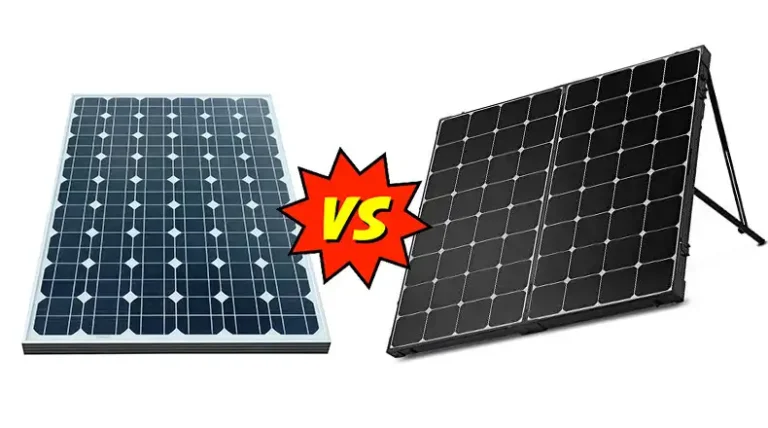Difference Between MPPT Inverter and MPPT Solar Charger?
Solar energy has been growing in popularity over the past decade. With concerns about climate change and rising electricity prices, more people are turning to solar panels to generate clean, renewable power. This allows homes and businesses to reduce their carbon footprint and utility bills.
To harness solar power, photovoltaic systems require specific equipment. Two critical components are the MPPT solar charger and MPPT inverter. While their names sound similar, these technologies serve different primary purposes. Understanding the distinction between the two is key for assembling an efficient solar setup.
MPPT stands for maximum power point tracking and enables solar panels to deliver optimal power. Inverters convert solar DC electricity into usable AC power. Meanwhile, MPPT chargers regulate charging batteries from solar panels. Confusing these devices or choosing mismatched components can undermine performance. Making informed selections between MPPT inverters and chargers based on needs is vital for successfully leveraging solar energy through effective system design.
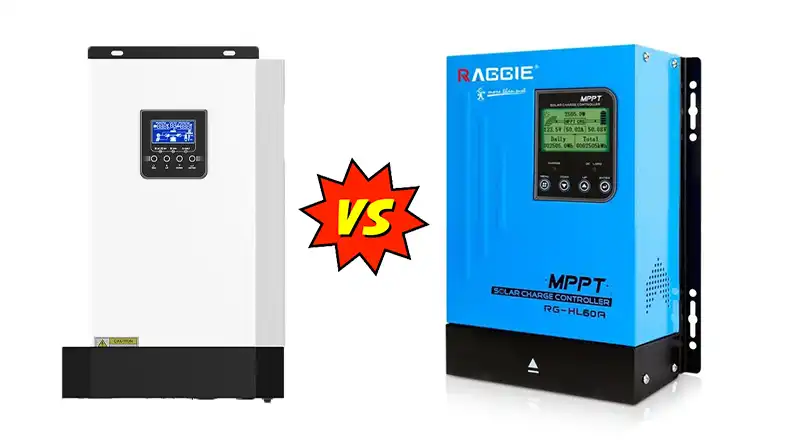
Explaining the MPPT Inverters
Sunlight paints your solar panels with a symphony of vibrant energy, but how does this radiant chorus translate into the hum of your appliances? Meet the inverter, the unsung hero silently orchestrating the transformation of the sun’s raw, direct current (DC) electricity into the familiar alternating current (AC) that powers your home. But not all inverters are created equal. Enter the MPPT inverter, a technological prodigy equipped with a secret weapon – Maximum Power Point Tracking (MPPT).
Think of the sun as a vast, unbalanced power curve. Traditional inverters operate like clumsy miners, extracting energy from a single, fixed point. But MPPT is a sophisticated surveyor, constantly mapping this curve and pinpointing the “maximum power point” – the sweet spot where your panels produce the most electricity.
MPPT inverters are efficiency champions, squeezing more power from your solar harvest compared to their non-MPPT counterparts. They can boost your energy production by up to 30%, especially when the sun plays hide-and-seek with clouds or the day dawns slowly. This translates to a fuller solar symphony, powering your home with less reliance on the grid and potentially reducing your electricity bill. Moreover, MPPT’s constant tracking ensures you never miss a beat in the sun’s power curve, maximizing your return on investment and minimizing your dependence on fossil fuels. It’s a win-win for your wallet and the planet.
MPPT’s versatility extends beyond residential rooftops. Its efficiency makes it ideal for large-scale commercial and industrial installations, where even a small percentage increase in energy production translates into significant cost savings. And it doesn’t stop there. MPPT seamlessly integrates with battery storage systems, allowing you to store excess solar energy for later use. Imagine enjoying the sun’s power even after it sets, thanks to MPPT’s ability to transform your solar system into a self-reliant energy orchestra.
The future is bright for MPPT, as it continues to conduct the symphony of a more efficient and sustainable future powered by the sun. So, whether you’re a homeowner, business owner, or simply someone who dreams of a brighter tomorrow, consider MPPT your trusted conductor in capturing the full potential of solar energy. Remember, it’s not just about generating electricity, it’s about harmonizing with the sun’s bounty to power your life and illuminate a brighter future for all.
B. Benefits of MPPT Inverters
With an MPPT inverter at the heart of your solar system, you’re not just harnessing the sun’s light, you’re maximizing its bounty. Compared to their non-MPPT counterparts, these technological powerhouses offer a symphony of benefits:
1. A Power Surge: MPPT technology unlocks the full potential of your solar panels, boosting your energy production by up to 30%. This means more sunshine converted into usable electricity, powering your home with less reliance on the grid. Imagine sunnier days reflected in your electricity bill, with potentially lower costs and increased energy independence.
2. Efficiency Under Every Sky: Non-MPPT inverters stumble in low-light conditions, like on cloudy days or mornings and evenings. But MPPT shines even when the sun plays hide-and-seek. Its constant tracking ensures you capture every precious watt, even in less-than-perfect lighting. No more sacrificing efficiency when the clouds roll in.
3. ROI Revolution: With increased energy production and improved efficiency, MPPT inverters become smart investments. You get more bang for your solar buck, maximizing your return on investment. This translates to quicker payback periods and a more sustainable financial future, powered by the sun.
4. A Greener Melody: By maximizing your solar energy harvest, MPPT inverters reduce your dependence on fossil fuels. This not only lightens your wallet but also lightens your environmental footprint. Every watt squeezed from the sun is a step towards a cleaner, greener future for the planet.
C. Applications of MPPT Inverters
MPPT inverters aren’t just technological marvels; they’re versatile performers, ready to power a symphony of energy solutions across diverse settings. Imagine them as the conductors, orchestrating the flow of solar energy in various locations and applications.
1. Grid-Tied Glory: MPPT inverters truly shine in grid-tied solar systems of all sizes. Whether you’re powering a cozy bungalow or a sprawling office complex, these efficiency champions ensure you capture every watt the sun offers. This translates to reduced reliance on the grid, potentially lower electricity bills, and a more sustainable energy profile for your home or business.
2. Commercial and Residential Installations: MPPT inverters are equally at home in urban landscapes and rural retreats. Their compact size and adaptability make them suitable for both residential and commercial installations, regardless of roof space or structural limitations. So, whether you’re a homeowner yearning for energy independence or a business owner seeking cost-effective solar solutions, MPPT inverters can harmonize with your needs.
3. Flexibility for the Future: The beauty of MPPT inverters lies not just in their power but also in their adaptability. They seamlessly integrate with battery storage systems, allowing you to store excess solar energy for later use. Imagine enjoying sunshine-powered electricity long after dusk, thanks to the flexibility MPPT brings to your system. This opens doors for off-grid applications, backup power solutions, and even a more self-reliant energy future.
With their adaptability, efficiency, and dedication to maximizing your solar harvest, MPPT inverters are more than just a technological marvel; they’re a key instrument in composing a brighter and more sustainable future, powered by the sun’s bounty.
Explaining the MPPT Solar Chargers
While sunlight paints the panels of your portable solar setup, a different kind of alchemy takes place within. Enter the MPPT solar charger, the unsung hero silently orchestrating the transformation of that radiant energy into the lifeblood of your devices – battery power. Unlike their non-MPPT counterparts, these technological maestros employ a secret weapon: Maximum Power Point Tracking (MPPT).
Think of a solar panel as a vast, unbalanced power curve. Traditional solar chargers operate blindly, extracting energy from a single, fixed point. But MPPT is a sophisticated surveyor, constantly mapping this curve and pinpointing the “maximum power point” – the sweet spot where your panel produces the most electricity.
This translates to faster and more efficient battery charging compared to non-MPPT chargers. Imagine reaching a full charge on your phone or laptop in record time, all thanks to the efficient work of your MPPT companion. Moreover, this intelligent optimization extends the lifespan of your batteries by preventing overcharging or undercharging, ensuring they’re always healthy and ready to power your adventures.
The versatility of MPPT extends beyond portable setups. You can find these efficiency champions in wall-mounted chargers for your home, ideal for keeping devices like tablets and cameras juiced up. They even power larger systems, ensuring efficient battery charging for caravans, boats, and remote applications.
So, whether you’re a globetrotting adventurer seeking the sun’s bounty on the go or a tech-savvy homeowner wanting the best for your devices, consider the MPPT solar charger your trusted conductor in the symphony of sustainable energy. Remember, it’s not just about powering your gadgets; it’s about harmonizing with the sun’s energy to fuel your freedom and illuminate a brighter future.
B. Advantages of MPPT Solar Chargers
With an MPPT solar charger at your side, you’re not just harnessing the sun’s light – you’re maximizing its power to fuel your adventures and everyday needs. Compared to their non-MPPT counterparts, these technological marvels offer a symphony of benefits:
1. Lightning Speed: MPPT technology unlocks the full potential of your solar panels, boosting charging speeds by up to 30%. Imagine reaching a full charge on your phone in a fraction of the time, allowing you to stay connected and powered wherever your journey takes you.
2. Battery Whisperer: MPPT isn’t just about speed; it’s about protecting your precious batteries. Its constant power curve tracking ensures you never overcharge or undercharge, extending battery life and keeping your devices healthy for the long haul.
3. Freedom Beyond the Grid: MPPT shines brightest in off-grid and mobile applications. Whether you’re conquering mountains on a backpacking trip or navigating the wilderness on a camping adventure, these compact powerhouses ensure your devices stay fueled by the sun.
4. Universal Harmony: MPPT’s versatility extends beyond smartphones. Laptops, cameras, tablets, and even larger devices like drones – these energy conductors can harmonize with a wide range of equipment, keeping your entire tech ecosystem vibrant and ready for action.
C. Applications of MPPT Solar Chargers
1. Freedom Unleashed: MPPT chargers are born for portable and off-grid adventure. Whether you’re trekking through mountains, setting sail on a boat, or simply enjoying a secluded cabin getaway, these compact powerhouses ensure your devices stay connected and powered by the sun’s bounty. No more scrambling for outlets or relying on dwindling batteries – the sun becomes your ultimate energy source.
2. When the Lights Go Out: MPPT’s efficiency makes it a natural partner for emergency preparedness and disaster relief. Imagine having a reliable source of power for communication, medical equipment, or simply staying informed during unexpected power outages. These solar chargers offer peace of mind knowing you can tap into the sun’s energy even when the grid falters.
3. Capturing Every Moment: Photographers, videographers, and outdoor enthusiasts rejoice! MPPT chargers ensure your cameras, drones, and other essential equipment stay juiced up, allowing you to capture the magic of nature without worrying about battery limitations. Imagine never missing a breathtaking sunset panorama or a once-in-a-lifetime wildlife encounter – MPPT keeps your creative energy flowing.
Comparing and Choosing: MPPT Inverters vs. Chargers
Utilizing the sun’s power for your home or portable needs brings a choice: MPPT inverters or MPPT solar chargers? While both utilize Maximum Power Point Tracking (MPPT) to maximize solar energy harvest, their functions and applications diverge. Let’s explore their key differences and guide you towards the perfect solar match.
Key Feature Comparison:
| Feature | MPPT Inverter | MPPT Solar Charger |
| Function | Converts DC from panels to AC for grid/appliance use | Directly charges batteries with DC from panels |
| Output | AC electricity (120/240V) | DC charging current |
| Applications | Grid-tied solar systems, home energy management | Portable & off-grid power, device charging |
| Cost | Generally higher | Moderate to low |
Choosing between these powerhouses depends on your specific needs and setup:
System Type: Grid-tied? An inverter seamlessly feeds solar energy to the grid. Off-grid? A charger fuels your batteries for independent power.
Power & Battery: High power needs and large batteries? An inverter might be more efficient. Need just basic device charging? A charger could suffice.
Budget: Inverters typically have higher upfront costs, while chargers can be more budget-friendly.
Portability: Need mobile power solutions? Compact chargers shine. Planning a fixed solar system? An inverter is the answer.
Convenience: Inverters integrate with appliances directly, while chargers require connecting devices individually.
Scenarios for Each Option
MPPT Inverter: Homeowner with grid-tied panels and battery storage powering home appliances and storing excess energy.
MPPT Solar Charger: Adventurer on a camping trip relying on solar panels to charge laptops, cameras, and smartphones.
Ultimately, the perfect solar solution lies in understanding your needs and harnessing the power of MPPT to maximize the sun’s bounty. Choose wisely, and let the sun illuminate your path to a brighter, more sustainable future!
People Also Ask (PAA)
Q1. I have a small solar panel and a portable battery. Do I need an MPPT inverter or charger?
A: If you simply want to charge your battery directly from the panel for off-grid use, an MPPT solar charger is perfect. Its compact size and focus on efficient battery charging make it ideal for mobile applications. An inverter, though, converts DC to AC for powering appliances, which you might not need in this scenario.
Q2. I love camping and want to keep my phone and camera charged with solar. Which option is more portable?
A: Go for the MPPT solar charger! Its lightweight design and portability make it an adventurer’s best friend. You can easily throw it in your backpack and harness the sun’s power wherever you roam, ensuring your devices stay juiced up for capturing epic moments.
Q3. I’m installing a rooftop solar system but also want battery backup. Does that mean I need both an inverter and charger?
A: Not necessarily! Some MPPT inverters come with built-in battery charging capabilities. This eliminates the need for a separate charger and simplifies your system setup. Just check the inverter’s specs to see if it has integrated battery charging features.
Q4. My budget is tight. Are there affordable options for solar power?
A: MPPT solar chargers are generally more budget-friendly than inverters, making them a great entry point into solar for hobbyists or occasional users. They offer efficient battery charging at a lower cost, ideal for powering smaller devices.
Q5. I’m looking for a future-proof solution. Which option is more versatile?
A: MPPT inverters tend to be more versatile, especially for grid-tied systems. They offer the flexibility to power your home while also storing excess energy in batteries for self-consumption or backup power. This provides greater independence and adaptability as your solar needs evolve.
Summing Up
Utilizing the sun’s reward efficiently depends on choosing the right MPPT. Inverters power homes and grid-tied dreams, while chargers fuel off-grid adventures and portable lifestyles. Whether you yearn for appliance independence or mobile solar freedom, understand your needs and pick your perfect match. Remember, MPPT technology unlocks the sun’s full potential, paving the way for a brighter, more sustainable future powered by the brilliance of choice. Let the sun be your guide!

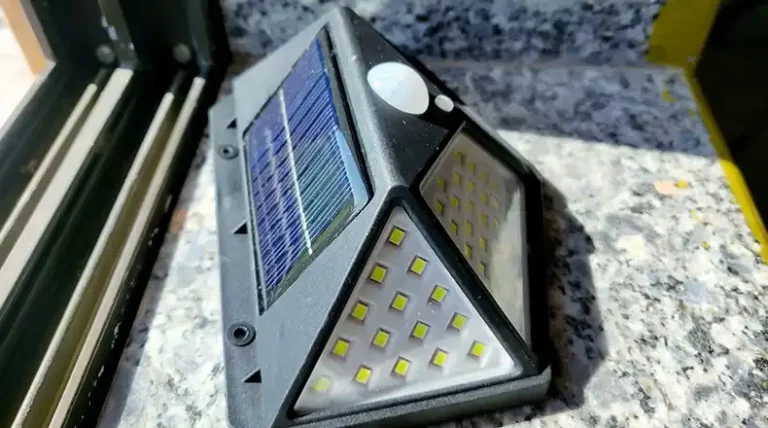
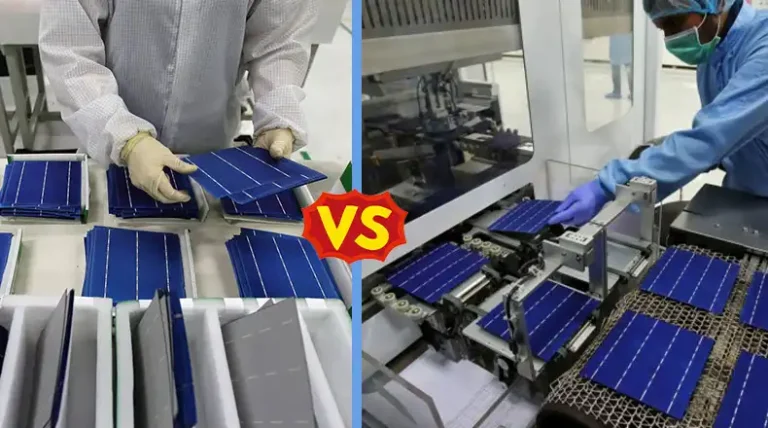
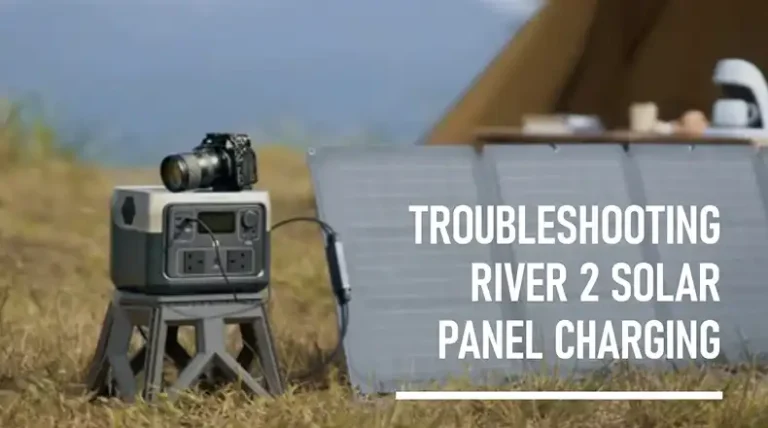
![[Answered] What Is a Safe Distance to Live From A Solar Farm?](https://www.itekenergy.com/wp-content/uploads/2023/07/What-Is-a-Safe-Distance-to-Live-From-A-Solar-Farm-768x428.webp)
